达尔文和他的进化论英文
- 格式:pptx
- 大小:633.48 KB
- 文档页数:13
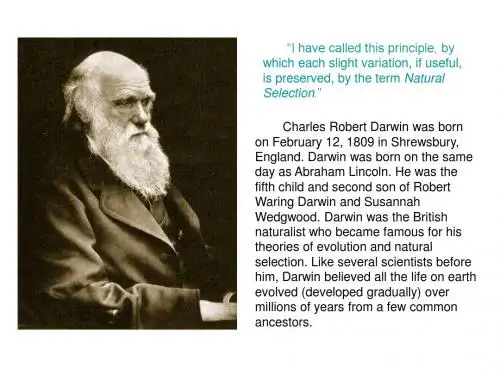
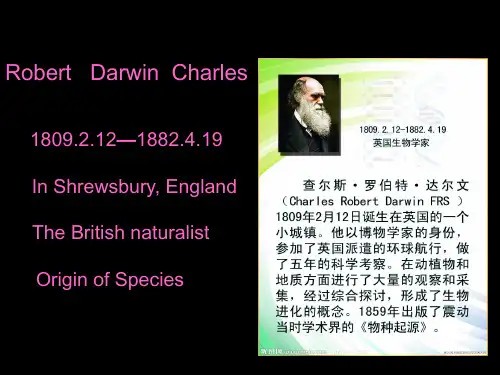

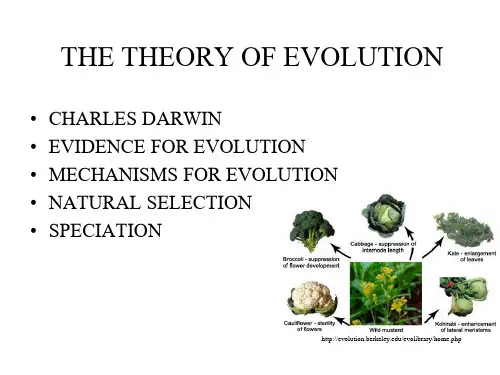
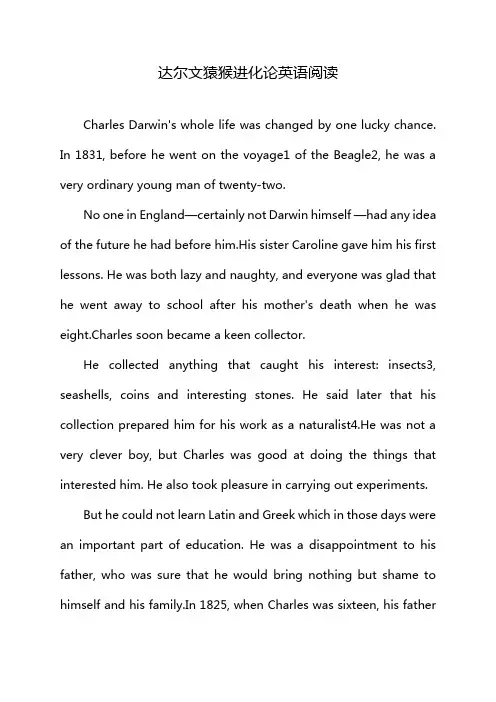
达尔文猿猴进化论英语阅读Charles Darwin's whole life was changed by one lucky chance. In 1831, before he went on the voyage1 of the Beagle2, he was a very ordinary young man of twenty-two.No one in England—certainly not Darwin himself —had any idea of the future he had before him.His sister Caroline gave him his first lessons. He was both lazy and naughty, and everyone was glad that he went away to school after his mother's death when he was eight.Charles soon became a keen collector.He collected anything that caught his interest: insects3, seashells, coins and interesting stones. He said later that his collection prepared him for his work as a naturalist4.He was not a very clever boy, but Charles was good at doing the things that interested him. He also took pleasure in carrying out experiments.But he could not learn Latin and Greek which in those days were an important part of education. He was a disappointment to his father, who was sure that he would bring nothing but shame to himself and his family.In 1825, when Charles was sixteen, his fathersent him to Edinburgh to study medicine, saying :“As you like natural history5 so much, perhaps we can make a doctor of you.”But Charles found the lectures boring, and the dissections6 frightening.But at Edinburgh he was able to go to natural history lectures. In 1826 he read a paper on sea-worms to the Natural History Society. This paper was his first known work on this subject.Then his father decided to send Charles to Cambridge University to study to become a priest.With hard work, he did quite well. And, in the countryside around Cambridge, he was able to shoot, fish and collect insects.He seemed likely to become a country priest like hundreds of others, sharing his time between his work and his interest in natural history and country life. He had a deep faith in God and a lasting interest in religion7.At this time he did not doubt that every word of the Bible was true.Then a letter from Captain Robert FitzRoy changed his life. FitzRoy was planning to make a voyage around the world on a ship called the Beagle. He wanted a naturalist to join the ship, and Darwinwas recommended8.That voyage was the start of Charles Darwin's great life work.In those days a great many people believed that every word written in the Bible was true. Darwin hoped that the plants and animals that they found in the course of their voyage would prove the truth of the Bible story of the great Flood9.He began to observe everything. When they got to Rio de Janeiro in South America, Charles was overcome with joy to see so many different creatures, so much life and colour.His notebooks were full of detailed observations.Then they reached dry land at Punta Alta. There Darwin discovered his first fossils10. Why, he wondered, were there horse bones at Punta Alta, when there had been no horses in the New World until Cortez brought his from Spain11?They came to Tierra del Fuego at the tip of South America. It was a strange place, with terrible storms. Its people grew no food, and they slept on the wet ground. Darwin observed their looks and habits.“How can people be so different, if all are descended12 from Adam and Eve in the Garden of Eden?” Charles wondered.A tripinto the mountains showed Darwin seashells at a height of 12,000 feet. Lower down were fossil trees.“So those trees once stood by the sea,” thought Darwin. “The sea came up and covered them. Then the sea-bed rose up...”.To a man who had been taught that every word in the Bible was true, this was very puzzling.In Chile, where Darwin saw earthquakes and volcanoes, he began to see what must have happened. The centre of the earth, he decided, was very hot. The surface of the earth was thinner in some places. It was in these places that earthquakes and volcanoes developed.As the Beagle sailed around the world, Darwin began to wonder how life had developed on earth. He saw volcanic islands in the sea, and wondered how living things had got there.But people who believed every word of the Bible thought that God had made all creatures and Man.But, if that was true, why did some of the fossils look like “mistakes” which had failed to change and, for that reason, died out?On went Beagle, to Tahiti13, New Zealand and Australia. There, Darwin saw coral and coral islands for the first time. How had theseislands come about14? Soon, he had the answer. Coral was made up of the bodies of millions of tiny creatures, piled up over millions of years —a million years for each island.Darwin wrote it all down in his notebooks.After five years he was home. He was never again the healthy young man who climbed mountains and carried heavy bags of fossils for miles.He set to work, getting his collection in order. And, in 1839, he married his cousin15, Emma Wedgwood. It was a happy marriage with ten children.He could be found working in his study, with a child beside him.His first great work The Zoology of the Beagle was well received, but he was slow to make public his ideas on the origins16 of life. He was certainly very worried about disagreeing with the accepted views of the Church.Happily, the naturalists at Cambridge persuaded Darwin that he must make his ideas public. So Darwin and Wallace, another naturalist who had the same opinions as Darwin, produced a paper together.A year later Darwin's great book, On the Origin of Species by Means of Natural Selection appeared. It attracted a storm.People thought that Darwin was saying they were descended from monkeys.What a shameful idea! Although most scientists agreed that Darwin was right and that the story of Adam and Eve was merely a story, the Church was still so strong that Darwin never received any honours for his work.Many years later, he published his other great work, The Descent of Man. He gave a lecture at the Royal Institution17, when the whole audience stood up and clapped18.His health grew worse, but still he worked. “When I have to give up observation, I shall die,” he said. He was still working on 17, April, 1882. He was dead two days later.。
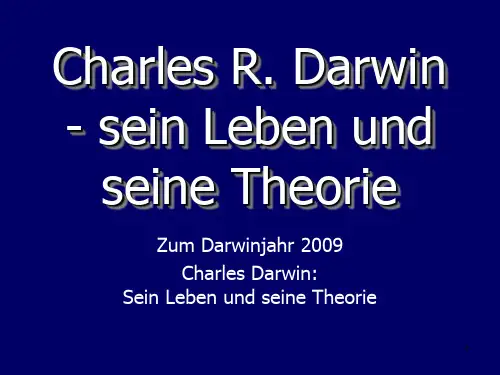
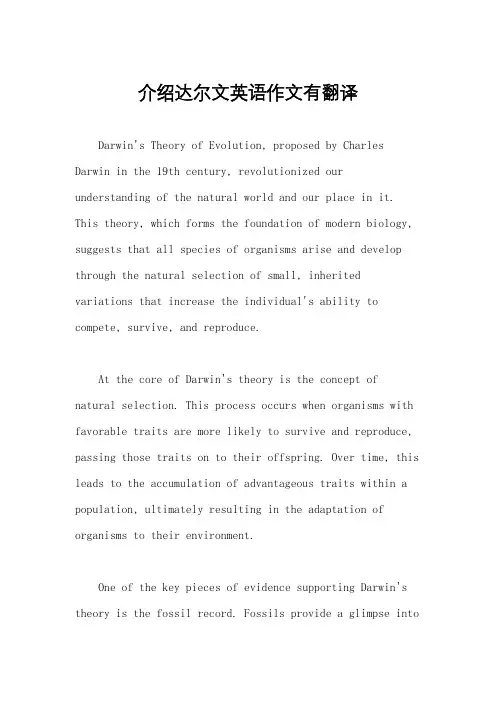
介绍达尔文英语作文有翻译Darwin's Theory of Evolution, proposed by Charles Darwin in the 19th century, revolutionized our understanding of the natural world and our place in it. This theory, which forms the foundation of modern biology, suggests that all species of organisms arise and develop through the natural selection of small, inheritedvariations that increase the individual's ability to compete, survive, and reproduce.At the core of Darwin's theory is the concept of natural selection. This process occurs when organisms with favorable traits are more likely to survive and reproduce, passing those traits on to their offspring. Over time, this leads to the accumulation of advantageous traits within a population, ultimately resulting in the adaptation of organisms to their environment.One of the key pieces of evidence supporting Darwin's theory is the fossil record. Fossils provide a glimpse intothe history of life on Earth, showing how organisms have changed over millions of years. For example, the fossil record clearly demonstrates the evolution of whales from land-dwelling ancestors to the marine mammals we see today.Another line of evidence comes from comparative anatomy. By comparing the anatomical structures of different species, scientists can uncover similarities that suggest a common ancestry. For instance, the similarity in the skeletal structures of humans, bats, and whales indicates that they share a common ancestor, despite their vastly different lifestyles.Furthermore, molecular biology has provided compelling evidence for evolution. DNA analysis allows scientists to compare the genetic code of different organisms, revealing similarities that reflect their evolutionary relationships. This molecular evidence not only supports the idea of common ancestry but also helps scientists trace the evolutionary history of specific traits.While Darwin's theory has faced criticism andrefinement over the years, it remains the cornerstone of modern biology. Its implications extend far beyond the realm of science, influencing our understanding of ourselves and our place in the natural world. By recognizing the interconnectedness of all living things and the processes that have shaped life on Earth, we gain a deeper appreciation for the beauty and complexity of the natural world.达尔文的进化论由19世纪的查尔斯·达尔文提出,彻底改变了我们对自然界及其地位的理解。
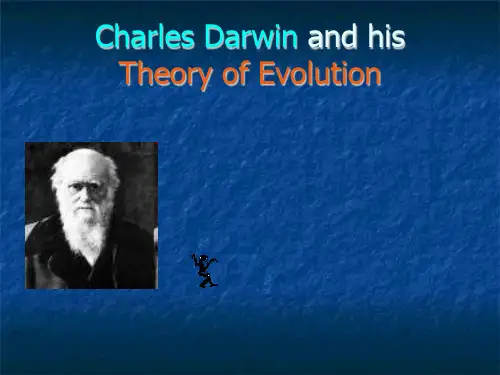
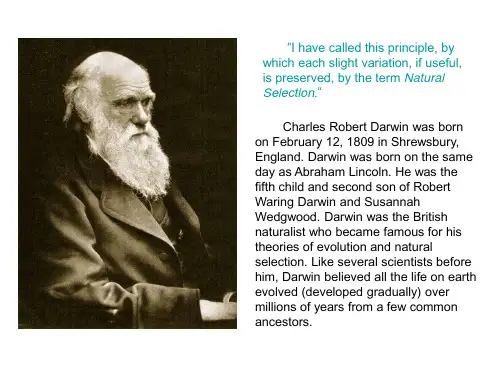
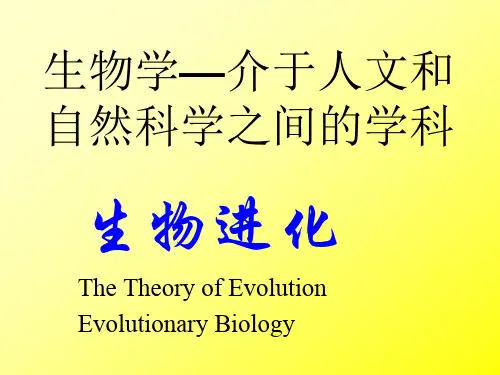
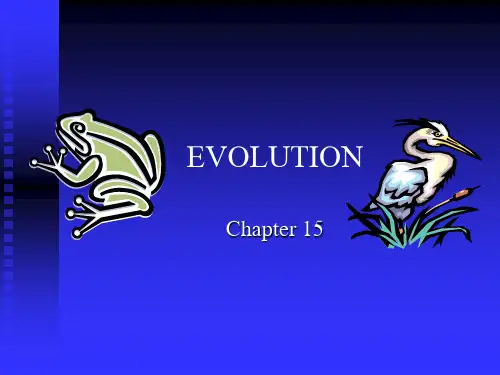
达尔文英文简介查尔斯·罗伯特·达尔文,英国生物学家,进化论的奠基人,摧毁了各种唯心的神造论以及物种不变论,下面是店铺给大家整理的达尔文英文简介,供大家参阅!查尔斯·罗伯特·达尔文简介Charles Robert Darwin, February 12, 1809 - April 19, 1882), British biologist, founder of evolution. Has been riding the Berger ship for 5 years of global voyage, animal and plant and geological structure, such as a large number of observation and collection. Published the "origin of species", put forward the theory of biological evolution, which destroyed a variety of idealistic gods and species invariance theory. In addition to biology, his theory of anthropology, psychology, philosophy development can not be ignored. Engels ranked "evolutionism" as one of the three discoveries of the natural sciences of the 19th century (the other two are the theories of cytology, conservation of energy) and have an outstanding contribution to mankind.On April 19, 1882, Darwin died at the village of Dawen at 73 years old and was buried in Westminster Abbey.查尔斯·罗伯特·达尔文成就Darwin himself said, "The main fun and the only thing I have in my life is my scientific work, and some of the most important scientific achievements that have been studied directly in the trip." For example, the famous " Study diary "and" Berger geology "," Berger's zoology "and so on. In his writings, the significance of "the origin of species", which is of particular historical significance, shows the progressive development of Darwin's theory of evolution and the theory of natural selection. The publication of the "origin of species" is a world event,because the publication of the "origin of species" marks the deepest view of the vast majority of learned people in the nineteenth century about the position of the biology and human beings in the biological world The change. The publication of the "origin of species" has led to the violent attacks on the Darwinian doctrines of the scientists and the telepathic scientists (who are the overwhelming majority), and have also led to the corresponding struggle to maintain Darwinism and actively participate in this There was a progressive naturalist in addition to the Darwinese, who had been a strong supporter of Darwinism everywhere.查尔斯·罗伯特·达尔文创立进化论After graduating from Cambridge University in 1831, his teacher Henslow recommended him as a "naturalist" identity to participate in the same year on December 27 British Navy "beagle" ship around the world scientific expedition sailing. First in the South America on the east coast of Brazil, Argentina and other places and the west coast and adjacent islands on the inspection, and then across the Pacific Ocean to Oceania, and then across the Indian Ocean to South Africa, and then around the Cape Atlantic by the Atlantic back to Brazil, and finally in October 1836 Day back to England. When he traveled around the world with the Beagle, he carried a few birds, and in order to feed the birds, he planted a grass called grass. The cabin was dark and only the windows were transmitted into the sun, and Darwin noticed that the grass seedlings were bent and grown in the direction of the window. But in the last few decades, Darwin was busy creating the theory of evolution until his later years before proceeding with a series of experimental studies on the issue of light, which was summed up in the book "Plant Movement"published in 1880. Darwin is using the seeds of grass to do these experiments. When the seeds of the grass germinate, the germs are covered with a layer of coleoptile, and the germs are first ground and the germs are protected from damage when they are unearthed. Darwin found that the coleoptile was the key to light. If the seeds are planted in the dark, their coleoptiles will grow vertically upwards. If the sun shines from one side of the seedlings, the sheath is bent in the direction of the sun. If the tip of the sheath is cut off, or covered with opaque things, although the light can also shoot the sheath, the sheath is no longer bending to the light. If the coleoptile is covered with transparent things, the coleoptile is bent toward the light, and even if the sheath is buried with opaque black sand, leaving only the tip, the buried sheath is still bent toward the light. Darwin speculates that a signal substance is secreted at the tip of the coleoptile and is transported down to the curved part, which causes the sheath to bend the sheath.The sailing changed the life of Darwin. After returning to England, he has been busy studying, determined to become a serious scientist to promote evolution. In 1838, he accidentally read T. Malthus's "theory of population", inspired by it, more certain that he is developing a very important idea: the world is not created within a week, the earth is older than the "Bible" Most of the animals and plants are changed, and still continue to change among the human, may be changed from a primitive animal, that is, Adam and Eve story is simply myth. Darwin realized that the survival struggle in the meaning of biological life, and realized that natural conditions is necessary for biological evolution of the "choice", the specific natural conditions are different, the choice is different, the choice of theresults are not the same.However, he was extremely cautious about the results of his research. In 1842, he began to write an outline, after which it extended to several articles. In 1858, Darwin decided to submit the Wallace article and his own part of the manuscript to the professional committee, in the light of the creative epiphany of the young naturalist R. Wallace. In 1859, "the origin of species,"a book came out, the first edition of 1250 that day sold out. After Darwin spent twenty years collecting information to enrich his species through the natural selection of the theory of evolution, and elaborate its consequences and significance.As a non-fist but creative man, Darwin avoided the controversy over his theory. Darwin wrote several books for scientists and psychologists when religious fanatical attack evolution was contrary to the creation of the Bible. The book "The Origin and Sex of Mankind" reports evidence of the evolution of mankind from the lower form of life, the evidence of the similarity of animal and human mental processes, and the evidence of natural selection in the evolutionary process.On April 19, 1882, the great scientist died of illness, and his body was buried at the tomb of Newton to express his admiration for the scientist.。
Charles Darwin and His Theory of EvolutionJ﹒G﹒CrowtherDuring the voyage of the Beagle, Darwin had been deeply impressed by similarities between existing South American animals and the fossil remains. He had noted how closely similar animals replaced one another when proceeding southward. He was struck by the South American character of the animals on the Galapagos archipelago, differing from island to island, and yet all the islands were recent and of the same age. It seemed utterly improbable that all of these myriad different yet similar species could each have been individually created. He felt that they could only be explained by supposing that they had sprung from a few original species which had gradually become modified. The subject haunted him.Though Darwin said that he started collecting facts on origin of Species without the guidance of any theory, his first notebook on the subject shows that he was in fact grappling with the problem of a scientific law which would explain how these modifications occurred. His mind went out to the law of gravitation. Before Newton, men had thought that each planet was individually kept in its course by God. There was no necessary relation between all of the moving bodies. In 1837, men believed that each individual species of animal was created by God, without necessary relation with any other species.But would it not be much more simple and sublime to suppose that after the creation of original animals, all their multifarious successions should arise from them by the operation of some fixed scientific law? This was one of the first ideas, a law which would do for biology what gravitation had done for astronomy.But what was the law? He tried to think it out, and almost succeeded. He noted that a variety of South American ostrich might have not been ‘well adapted, and thus perish ’, while in a variety with favourable qualities ‘ many might be produced ’. this required the principle that some variations survive because they are adapted to changing circumstances and that the‘death of species is a consequence of non –adaptation to circumstances’ .Darwin had almost worked out the idea of natural selection and the survival of the fittest, but they did not become quite clear to him until the following year, 1838, when he happened to read Malthus’Essay on the principle of population. Malthus said that ‘population, when unchecked, increases in a geometrical ratio…This implies a strong and constantly operating check on population from the difficulty of subsistence…’Darwin saw at once that ‘ under these circumstance ’ favourable variations would tend to be preserved and unfavourable ones to be destroyed. The result of this would be the formation of a new species. Here then I had a theory by which to work.Darwin established the evolutionary method by using it to explain the origin of species. But he also showed how to use it in many other directions. In his descent of man he showed how it could be applied in anthropology, and in The Expression of the Emotions in man and animals, to psychology.By showing that one species must have arisen from another, he raised the question of how, and thus founded the science of genetics. He explored this science in his Variations of Animals and Plants under Domestication, and said that ‘ a grand and almost untrodden field of inquiry will be opened, on the cause and law of variation, on correlation, on the effects of use and disuse, on the direct action of external conditions, and so on…’He threw out scores of ideas which have contained profound truths, even in some of his most criticized conceptions, such as Pangenesis. In this he ascribed the mechanism of heredity to physical entities which he called gemmules, supposed to connected with every part of body. The modern knowledge of genes and hormones has confirmed his fundamental idea.He buttressed his technical position with huge monographs on barnacles, and important works on coral reefs, the fertilization of flowers by insects, climbing and movement in plants, crossing, and a big final volume on The Formation of vegetable mould, through the Action ofWorms, published in the year before he died.His range of enquiry was astonishing, and his power of drawing important conclusions from inconspicuous details unequalled. Nevertheless, time has, of course, emphasized many of the obscurities of which he was himself very much aware. While the fact of evolution became obvious, its inner mechanism, in spite of all the biological research of the last hundred years, is still under sharp dispute.Why did Darwin’s work have such an effect, not only on science, but on the whole of human thought? It was because it contained principles which were of interest to many different classes in society.[ 806 words ]译文:查尔斯﹒达尔文进化论J﹒G﹒克劳瑟在小猎犬号的航程中,达尔文对南美洲的动物与动物化石之间的相似性留下了深刻印象。
达尔文的进化论在英语中被称为Darwin's Theory of Evolution。
达尔文(Charles Darwin)的进化论主张物种是通过自然选择和适者生存的方式逐渐演变的。
他的理论在1859年的《物种起源》一书中得到了全面的阐述。
根据这个理论,生物体具有遗传变异,这些变异在生存竞争中会导致某些个体比其他个体更适应环境,从而更有可能生存并传递其遗传特征给下一代。
这一过程导致物种的逐渐变化和新物种的形成。
Darwin's Theory of Evolution 是生物学中的一个基本概念,对现代生物学和生态学产生了深远的影响,并对我们对生命和自然界的理解产生了巨大影响。